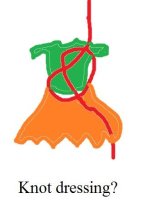Such questions are worth an addendum of sorts (the question is >120days old, but is likely to be re-raised or otherwise wondered about anyway).
To the OP, do note that often a knot isn't presented with what should be "proper dressing". In the case at hand --even though it's a commonly used knot (!)--, OnRope1 repeats as its knot image an impossible-to-realize structure that was easy for the artist to draw : where one line simply traces the other; note how the cited video above has nicely shown the knot symmetrically dressed, and how that differs from the simplistic image (which is much copied in many sources). In the dressing (correct) done in the video, one end comes into the knot and bears against its twin --this is the challenged dressing--, and the twin part comes in and bears against other parts of the knot, pulling away from its twin.
And re dressing, "undressed"/"sloppy" have NO particular form, so what might result in one case can hardly be taken as representative of others. I recall someone citing some AMGA testing of mis-dressed fig.8 knots (eye knots, I think; or end-2-end ones) which found that they were on average stronger. But, typical of such reports, there was no indication of how their properly dressed knot was done --and as this video cites, which of the twin ends bore the load.
As others have noted, proper dressing makes it easier to recognize that you've tied what you want; and that knots in rope typically are NOT going to break (and that proper USE will not see a 10%-pt.s difference making any difference!).
AND a mis-dressed knot might be
less secure --it it comes loose, it loses all strength!
IMO, the claim this examiner (and OnRope1) thinks has been refuted could be substantiated were the knot SET as follows : load the tail against the eye, and then (iterate) load the eye against the knot body. The point is to anticipate the straightening of the to-be-loaded strand by putting as much curvature in it by setting, and THEN that highly loaded main strand should see some force transfer at the deflections made through the twin turns of the eye legs' turn around it (at the entry point) and against the twin part (unloaded tail) as it reaches through the knot body to make its turn around the eye legs. Lyon Equipment tested the fig.8, overhand, & fig.9 eyeknots, and remarked about this particular difference in loading : although their testing was less than thorough, they concluded that for the overhand it was better in the way similar to what the video shows
for the fig.8 (i.e., load the strand that bears INTO its twin (which reaches farther to turn around the eye legs); for the fig.8 that it was a toss-up, and for the fig.9 (oh, also a fig.10, IIRC) ... well, I forget. And, of course, YMMV with materials.
AND ... (again), it shouldn't matter to actual use. Maybe the rope sees less injury in some high-tensioned high-line rigging?
Btw, Dave Merchant suggests a slightly different, symmetric dressing, in which the main strand sort of crosses over the other; he believes that the challenged dressing of the video (which is easier to achieve!) will result in a harder-to-untie knot.
-SirK* (who alas hasn't been minding these pages for a lonnnng time :-[ )
ps : Get a load of OnRope1's comical mis-use of % efficiencies in strength reduction,
given in their Myth #15
Unless any of the three are excessive, i.e. a 20 year old wet rope with an overhand knot (50-55% efficiency) can push a rope beyond its life support abilities.
( -40% age, -15% wet, -45% knot) = 0 strength.
Now, really, how can this STILLLLL be posted --it's SO damn silly!


